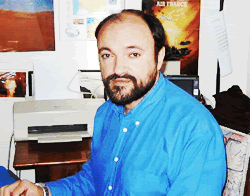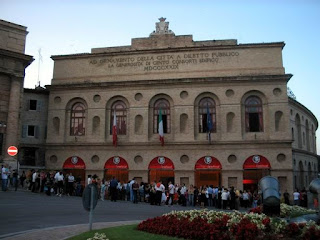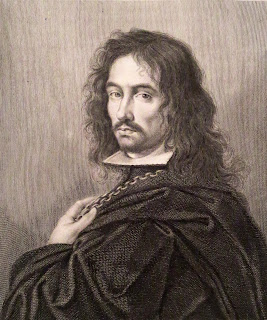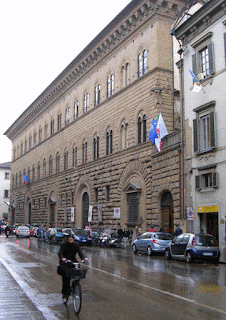Artist whose talents rivalled Raphael
 |
| Domenichino's picture St John the Evangelist sold for £9.2 million in 2009 |
The painter Domenico Zampieri, in his era spoken of in the
same breath as Raphael, was born on this day in 1581 in Bologna.
Better known as Domenichino (“Little Domenico”), the
nickname he picked up early in his career on account of his small stature, he painted
in classical and later Baroque styles in Rome, Bologna and Naples.
Noted for the subtle, almost serene lighting and understated
colours of his compositions, he painted portraits, landscapes, religious and
mythological scenes and had a prolific output. Among his most notable works
were significant frescoes commissioned by Cardinal Alessandro Farnese for the
Badia (monastery) at Grottaferrata, outside Rome, and for Cardinal Pietro
Aldobrandini at the Villa Belvedere (also known as the Villa Aldobrandini) in
nearby Frascati, as well as Scenes from the Life of Saint Cecilia at the church
of San Luigi dei Francesi, not far from Piazza Navona, in Rome itself.
Domenichino’s paintings can be seen in art galleries in many
countries, with the largest single collection held by the Louvre in Paris.
One of his most celebrated paintings, the depiction of St
John the Evangelist that he worked on between 1621 and 1629 and which has been described
as a “masterpiece epitomising the grandeur and nobility of Roman Baroque",
sold for £9.2 million at auction in London in December 2009 only to be the
subject of an intervention by the British government to keep it from leaving
the United Kingdom.
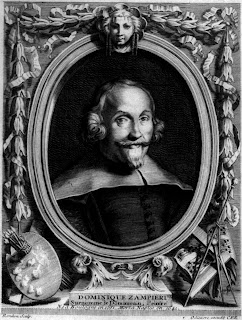 |
| Domenichino's talent put him not far behind Raphael among the Italian greats |
The painting had been on a wall at the Glyndebourne Opera
House in Sussex for more than 100 years, having been bought by the owners of
the house for 70 guineas in 1899. Put up for sale at Christie’s it was bound
for the United States before the culture minister, Margaret Hodge, imposed an
export bar. It was sold eventually to a British buyer on condition that it was
on public display for at least three months each year.
The son of a shoemaker, Domenichino studied in Bologna,
first in a local studio and then joining Lodovico Carracci’s Accademia degli
Incamminati.
He left Bologna for Rome in 1602 to work under Annibale
Carracci and became one of the most talented apprentices to emerge from Carracci's
supervision.
Following Annibale Carracci's death in 1609, his Bolognese
pupils, the best of whom were Domenichino, Francesco Albani, Guido Reni and Giovanni
Lanfranco, became the leading painters in Rome, upstaging even the followers of
Caravaggio, who had left Rome in 1606.
Domenichino's masterpiece, his frescoes of Scenes of the
Life of Saint Cecilia in the Polet Chapel of San Luigi dei Francesi, was
commissioned in 1612 and completed in 1615.
At the same time he was painting his most celebrated altarpiece,
The Last Communion of Saint Jerome, for the church of San Girolamo della Carità, noted
for the accuracy of facial expressions, which would subsequently be compared
with Raphael's great Transfiguration and was at one time hailed as "the
best picture in the world".
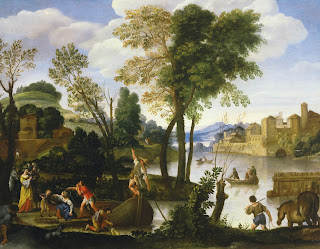 |
| Domenichino's River Landscape with Boatmen and Fishermen demonstrates qualities that influenced many landscape painters |
He would later move away from the rigid classicism of his
early work towards a broader, less conventional Baroque style, evident in the
last works he produced in Rome and in his fresco cycle, Scenes from the Life of
San Gennaro (1631–41), which he painted for the Cappella del Tesoro di San
Gennaro, in the Duomo in Naples.
Throughout the 17th and 18th centuries Domenichino’s
paintings were regarded as second only to those of Raphael.
His work fell from favour in the mid-19th century but his importance
to the evolution of Baroque classicism was recognized again in the 20th century.
Domenichino also occupies an important place in the history
of landscape painting, his work known to have had a deep influence on the
classical landscapists Nicolas Poussin and Claude Lorrain. In 1996 the first major exhibition of his
work was held at the Palazzo Venezia in Rome.
He died in Naples in 1641 while still working at the Duomo.
There were suspicions he had been poisoned by the Spanish painter Jusepe di
Ribera, the leading member of a group of three artists known as the Naples
Cabal, furious to have been passed over for the Cappella del Tesoro di San
Gennaro commission in favour of an outsider.
 |
| Part of the Domenichino fresco cycle at San Luigi dei Francesi |
Travel tip:
The Baroque church of San Luigi dei Francesi can be found in
Via della Dogana Vecchia, a couple of blocks to the east of Piazza Navona in
the heart of Rome’s historic centre. Built in the 16th century to serve the
French community in Rome, it is notable not only for Domenichini’s fresco
Scenes from the Life of Saint Cecilia but for the cycle of paintings by Caravaggio
about the life of St. Matthew in the Contarelli Chapel.
 |
| The Cattedrale di San Gennaro, as the Naples Duomo is more frequently known |
Travel tip:
The Duomo of Naples, known locally more often as the
Cattedrale di San Gennaro, was completed in the 14th century after
being commissioned by King Charles I of Anjou, the youngest son of Louis VIII
of France. Nowadays the seat of the Archbishop of Naples, it is most famous for
housing a vial supposedly containing the dried blood of San Gennaro, the city’s
patron saint. The blood is put on public
display twice a year, in May and September, when it usually is seen miraculously
to liquefy. If the blood fails to liquefy on these days, legend has it that a
disaster will befall Naples. Many have doubted the authenticity of the blood
and the miracle. A recent hypothesis is
that it actually contains iron oxide (rust) in the form of a thixotropic gel
that has the colour of old blood and would become less viscous if shaken or
otherwise agitated, and therefore appear to liquefy.






